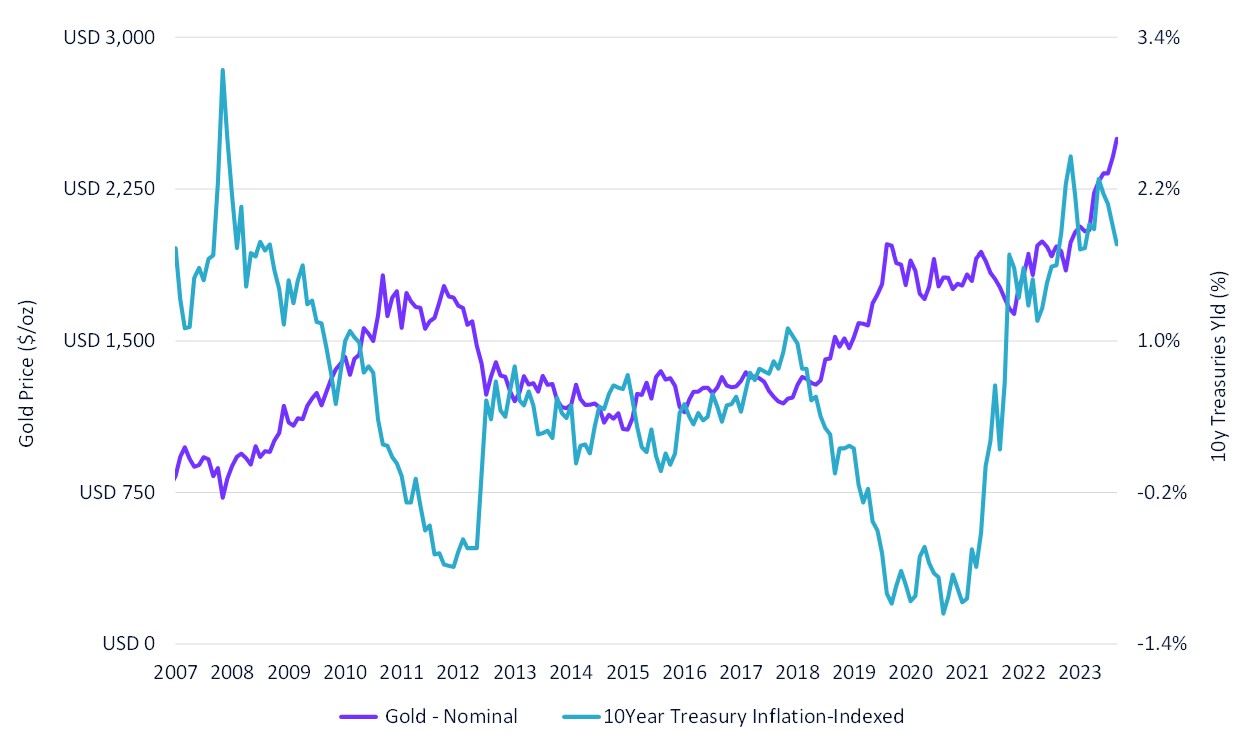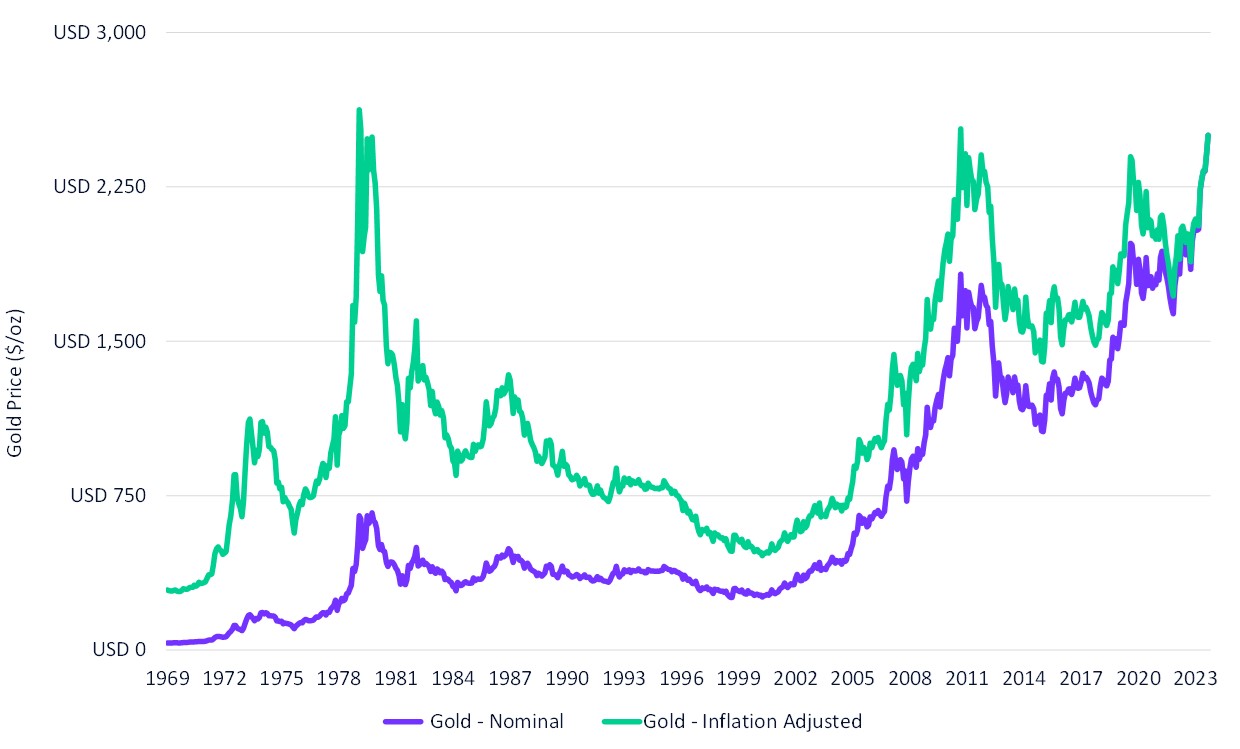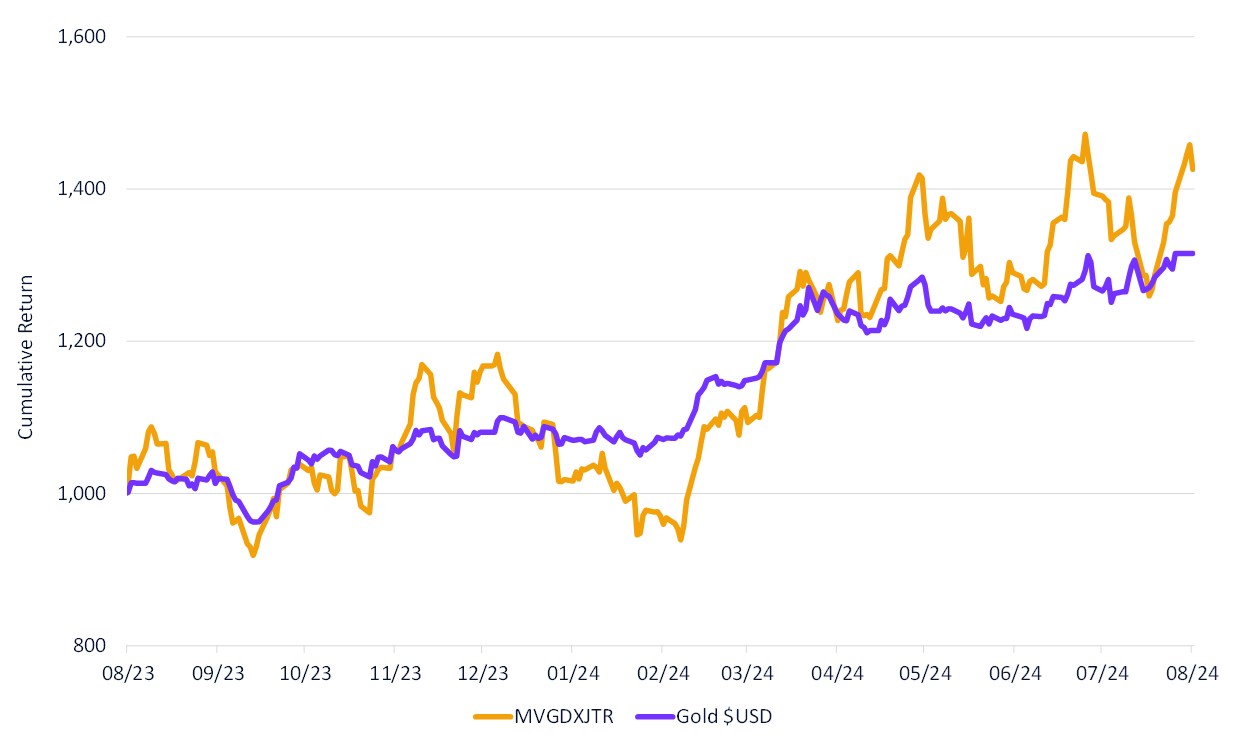In August, gold reached its all-time high surpassing USD 2500 per oz., delivering an annualized rate of return of 3.6% since 1980. With gold bars typically weighing about 400 ounces, USD 2500 per oz., means each bar is now worth more than USD 1 million versus USD 250,000 at the 1980s price of USD 625 per oz. Is now the time to sell that Rolex Daytona Gold watch or should you hold on for those expected rate decreases?
How do interest rates impact Gold Prices?
Historically, gold is negatively correlated to interest rates – gold prices go up when interest rates go down, and prices go down when interest rates go up. Gold does not provide cash flows, so there is an opportunity cost for holding gold when investors can get more attractive returns in other assets like stocks and bonds.
Exhibit 1: Gold and Interest rates

Source: MarketVector, Bloomberg, Federal Reserve Bank of St. Louis. Data as of August 25, 2024.
Market Yield on U.S. Treasury Securities at 10-Year Constant Maturity, Quoted on an Investment Basis, Inflation-Indexed, Percent, Daily, Not Seasonally Adjusted.
Will Gold Continue to Rise?
It’s important to note that, when adjusted for inflation, the 1980s is still the peak for gold. Although inflation is trending down, it has been stubbornly sticky, and if it stays higher for longer, there might still be room for gold to catch up.
Exhibit 2: Gold Price - Nominal vs. Inflation-Adjusted

Source: MarketVector, VanEck. Data as of August 25, 2024.
Note: January 1980’s intra-month high of USD 815 (in nominal terms) would be equal to approximately USD 2,819 in today’s (2024) dollars.
Gold prices are primarily driven by supply and demand. Gold sources of demand are diversified across jewelry, technology, investors (including ETFs), and central banks, providing diverse drivers for gold prices. This diversity of demand underpins gold’s robust qualities as an investment asset. Since 2021, central banks around the world have increased their reserves in gold, almost doubling the average quarterly demand over the previous. Since May 2024, European and North American ETFs have seen net inflows reversing the previous outflow trend and catching up to Asian ETF inflows1.
What next for Gold Stocks?
With expected interest cuts in September and weakening dollar, this should attract more US investors back into gold ETFs. Indeed, gold related stocks, such as gold miners, which have previously delinked from gold prices, are now reclaiming their role as leveraged play on gold prices. The MVIS® Global Junior Gold Miners Index (MVGDXJTR), which tracks the performance of the most liquid small-cap companies in the global gold and silver mining industries, is up 42% over the last 1 year (as of August 22, 2024). The return of interest rate cuts, US demand, combined with the potential impact of sticky inflation and higher for longer has the potential to drive gold prices up further beyond all-time highs, inflation adjusted.
Exhibit 3: MVIS® Global Junior Gold Miners Index (MVGDXJ) and Gold USD 1 year Performance

Source: MarketVector, World Gold Council. Data as of August 25, 2024.
Source1: World Gold Council, |Gold ETF Flows: July 2024. https://www.gold.org/goldhub/research/gold-etfs-holdings-and-flows/2024/08
For more information on our family of indexes, visit www.marketvector.com.
Joy Yang is the Head of Product Management and Marketing at MarketVector. She is responsible for managing MarketVector products and services to accelerate innovation in financial index design and adoption. Joy brings more than 25 years of investment experience to MarketVector, having led teams delivering index and quantitative-active investment solutions at Arabesque Asset Management, Dimensional Fund Advisors, Vanguard, Aberdeen Standard Investments, AXA Rosenberg, and Blackrock. She has an MBA from the University of Chicago Booth School of Business and a Bachelor of Science in Electrical Engineering from Cooper Union’s Albert Nerken School of Engineering.
For informational and advertising purposes only. The views and opinions expressed are those of the authors but not necessarily those of MarketVector Indexes GmbH. Opinions are current as of the publication date and are subject to change with market conditions. Certain statements contained herein may constitute projections, forecasts, and other forward-looking statements, that do not reflect actual results. It is not possible to invest directly in an index. Exposure to an asset class represented by an index is available through investable instruments based on that index. MarketVector Indexes GmbH does not sponsor, endorse, sell, promote, or manage any investment fund or other investment vehicle that is offered by third parties and that seeks to provide an investment return based on the performance of any index. The inclusion of a security within an index is not a recommendation by MarketVector Indexes GmbH to buy, sell, or hold such security, nor is it considered to be investment advice.
Get the latest news & insights from MarketVector
Get the newsletterRelated:




